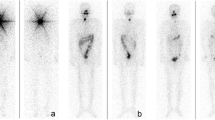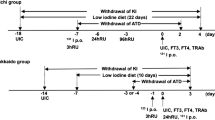Abstract
Purpose
To decrease the risk of recurrence or metastasis in differentiated thyroid cancer (DTC), selected patients receive radioactive iodine ablation of remnant thyroid tissue or tumor. A low iodine diet can enhance uptake of radioactive iodine. We compared the success rates of radioactive iodine ablation therapy in patients who followed two different low iodine diets (LIDs).
Materials and Methods
The success rates of postsurgical radioactive iodine ablation in DTC patients receiving empiric doses of 150 mCi were retrospectively reviewed. First-time radioactive iodine ablation therapy was done in 71 patients following less strict LID and 90 patients following very strict LID. Less strict LID restricted seafood, iodized salt, egg yolk, dairy products, processed meat, instant prepared meals, and multi-vitamins. Very strict LID additionally restricted rice, freshwater fish, spinach, and soybean products. Radioactive iodine ablation therapy was considered successful when follow-up 123I whole body scan was negative and stimulated serum thyroglobulin level was less than 2.0 ng/mL.
Results
The success rate of patients following less strict LID was 80.3% and for very strict LID 75.6%. There was no statistically significant difference in the success rates between the two LID groups (p = 0.48).
Conclusions
Very strict LID may not contribute to improving the success rate of initial radioactive iodine ablation therapy at the cost of great inconvenience to the patient.

Similar content being viewed by others
References
Schlumberger MJ. Papillary and follicular carcinoma. N Engl J Med. 1998;338:297–306.
Goslings BM. Proceedings: effect of a low iodine diet on 131I therapy in follicular thyroid carcinomata. J Endocrinol. 1975;64:30p.
Maxon HR, Thomas SR, Boehringer A, Drilling J, Speriling MI, Sparks JC, et al. Low iodine diet in I-131 ablation of thyroid remnants. Clin Nucl Med. 1983;8:123–6.
Lakshmanan M, Schaffer A, Robbins J, Reynolds J, Norton J. A simplified low iodine diet in 131I scanning and therapy of thyroid cancer. Clin Nucl Med. 1988;13:866–8.
Goslings BM, Hannon R. The effect of a low iodine diet on 131I therapy in follicular carcinoma. Neth J Med. 1973;16:136–7.
Maruca J, Santner S, Miller K, Santen RJ. Prolonged iodine clearance with a depletion regimen for thyroid carcinoma: concise communication. J Nucl Med. 1984;25:1089–93.
Morris LF, Wilder MS, Waxman AD, Braunstein GD. Reevaluation of the impact of a stringent low-iodine diet on ablation rates in radioiodine treatment of thyroid carcinoma. Thyroid. 2001;11:749–55.
Warren Grant Magnuson Clinical Center, National Institutes of Health. Preparing to receive 131I: the low-iodine diet. Patient information publications. 2000.
Memorial Sloan-Kettering Cancer Center. The low iodine diet. Patient information booklet, 6th ed. 2010. http://www.mskcc.org/patient_education/_assets/downloads-english/400.pdf.
Thyroid Cancer Survivors’ Association, Inc. Low-iodine cookbook—guidelines and tips for the low-iodine diet used for a short time when preparing to receive radioactive iodine, 7th ed. 2010. http://www.thyca.org/Cookbook.pdf. Accessed March 29, 2010.
The American Thyroid Association (ATA) Guidelines Taskforce on Thyroid Nodules and Differentiated Thyroid Cancer. Revised American Thyroid Association management guidelines for patients with thyroid nodules and differentiated thyroid cancer. Thyroid 2009;19:1167–214.
National Comprehensive Cancer Network, Inc. Practice guidelines in oncology—thyroid carcinoma v.1. 2010. www.nccn.org/professionals/physician_gls/pdf/thyroid.pdf. Accessed January 14, 2010.
Maxon HR, Thomas SR, Hertzberg VS, Kereiakes JG, Chen I, Sperling MI, et al. Relation between effective radiation dose and outcome of radioiodine therapy for thyroid cancer. N Engl J Med. 1983;309:937–41.
Cavalieri RR. Iodine metabolism and thyroid physiology: current concepts. Thyroid. 1997;7:177–81.
Ladenson PW, Braverman LE, Mazzaferri ME, Brucker-Davis F. Comparison of administration of recombinant human thyrotropin with withdrawal of thyroid hormone for radioactive iodine scanning in patients with thyroid carcinoma. N Engl J Med. 1997;337:888–96.
Tomoda C, Uruno T, Takamura Y, Ito Y, Miya A, Kobayashi K, et al. A reevaluation of stringent low iodine diet in outpatient preparation for radioiodine examination and therapy. Endocr J. 2005;52:234–40.
Roh JH, Kim BI, Ha JS, Chang SJ, Shin HY, Choi JH, et al. Comparison of urine iodine/creatinine ratio between patients following stringent and less stringent low iodine diet for radioiodine remnant ablation of thyroid cancer. Nucl Med Mol Imaging. 2006;40:322–6.
Choi JH, Kim HI, Park JW, Song EH, Ko BJ, Cheon GJ, et al. Analysis of urine iodine excretion decrease by two-week stringent low iodine diet for remnant thyroid ablation with radioactive iodine in Korean patients with thyroid cancer; prospective study. Nucl Med Mol Imaging. 2008;42:375–82.
Tala Jury HP, Castagna MG, Fioravanti C, Cipri C, Brianzoni E, Pacini F. Lack of association between urinary iodine excretion and successful thyroid ablation in thyroid cancer patients. J Clin Endocrinol Metab. 2010;95:230–7.
Pluijmen MJHM, Eustatia-Rutten C, Goslings BM, Stokkel MP, Arias AMP, Diamant M, et al. Effects of low-iodine diet on postsurgical radioiodine ablation therapy in patients with differentiated thyroid carcinoma. Clin Endocrinol (Oxf). 2003;58:428–35.
Hinds SR, Stack AL, Stocker DJ. Low-iodine diet revisited: importance in nuclear medicine imaging and management. Clin Nucl Med. 2008;33:247–50.
Disclosure Statement
We declare that we have no conflict of interest.
Author information
Authors and Affiliations
Corresponding author
Rights and permissions
About this article
Cite this article
Yoo, I.D., Kim, S.H., Seo, Y.Y. et al. The Success Rate of Initial 131I Ablation in Differentiated Thyroid Cancer: Comparison Between Less Strict and Very Strict Low Iodine Diets. Nucl Med Mol Imaging 46, 34–40 (2012). https://doi.org/10.1007/s13139-011-0111-y
Received:
Revised:
Accepted:
Published:
Issue Date:
DOI: https://doi.org/10.1007/s13139-011-0111-y




